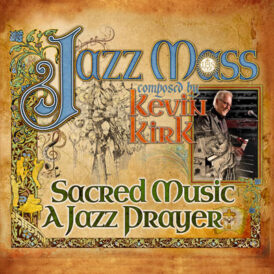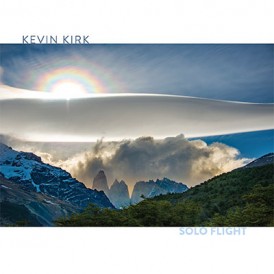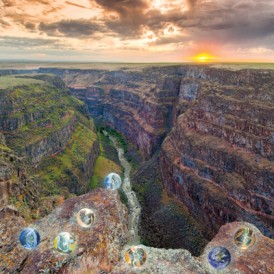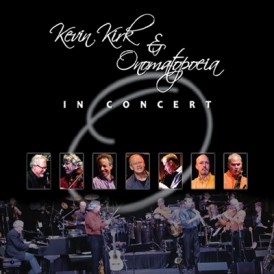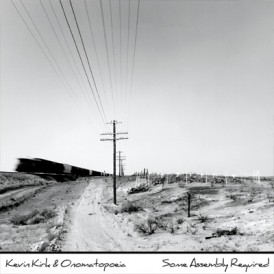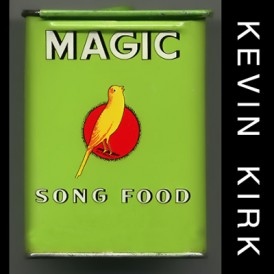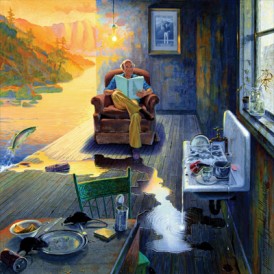Who are the men who make that “blopbadabebopbahdoolyooppadoo*” that can only describe the music of Onomatopoeia?
*Pat Hyneman’s onomatopoetic description of Onomatopoeia.
How did it all get started?
According to the band founder Kevin Kirk, “If you enjoy Onomatopoeia, you can thank Mozart.” In 1991, Kirk received a phone call from philharmonic conductor James Ogle who needed a recorded sample of “brass malleted glockenspiel” for a performance of The Magic Flute. He recommended Kirk work with violist Tom Tompkins to construct the effect. Little did he know he was putting in motion a collaboration that would outlive this project by over 20 years. Kirk was familiar with Tompkins’ work. He remembers, “I quickly asked, “Tom Tompkins from the band Providence, who recorded and toured with members of the Moody Blues?” Ogle replied, ‘Come to think of it, he does have a gold record on the wall of his office.” Kirk phoned Tompkins and the rest is history. Kirk remarked, “I sensed halfway through our first conversation that we would be lifelong friends.” Later that year, they created Onomatopoeia, a band with complex musical arrangements for classical and jazz instrumentation.
How do you describe the music that the band plays?
Drummer Jon Hyneman suggested, “New Age Funky Jazz with a Classical Twist?”
Percussionist Pat Hyneman called it “Cultural Overlay”.
Saxophonist (and Aikido practitioner) Greg Perkins answered with a koan: “What is the sound of one genre exploding and melting into another, Grasshopper?”
Kirk offered, “Onomatopoeia sounds honest and fun because we are honestly having fun. It’s the kind of music that occurs when every participating musician is respected and considered to be invaluable. It’s what happens when great musicians are given the green light to make the kind of music they’ve always wanted to make but nobody ever let them.”
Perkins added, “Onomatopoeia works because Kevin has a gift for coming up with the hearts of songs that people love and because the band has so much fun spinning out their implications.
What does it feel like to play the compositions on stage as an ensemble?
Perkins responded, “It feels like being in a musical Cirque du Soleil troupe: working with highly skilled people who love doing what they are doing, and are so into the experience that working without a net just doesn’t matter.” He added, “(playing for an audience) adds energy and chaos, and that opens up our potential for brilliant things to happen.”
Kirk asserted, “To be on stage with Ono is, simply put, the most exciting and profound experience that I could imagine having in music.” He added, “Members smile at you, encourage you. We all truly listen to each other. It is essentially because we all really care and are amazed every time one of us goes for it and achieves a new level.”
Bassist Mike Seifrit agreed, “We encourage each other to take chances.”
What are you thinking about when you play?
Kirk explained that if the piece is biographical he meditates on the person for whom he wrote it, but he laughed, “My honest answer is that I am praying that I remember the dang arrangement.”
Everyone agreed; onstage, they are thinking music.
Perkins added, “If I’m thinking, I’m thinking about how to stop thinking and get into the musical moment.”
Tompkins explained his experience is about more than his head: “The thinking side of me is thinking about music, which is very technical and doesn’t leave a lot of room for day dreaming, but a good portion of me is not thinking; it’s feeling. I feel the audience, the band, the moment.”
What are some of your favorite Onomatopoeia moments?
Perkins described a moment from his first concert with the band when someone accidentally moved a big cue so that it was “out of phase” with the music. For the song to continue without a big clam, every single member had to have noticed what had happened and make the same simultaneous decision either to stick with the original plan or to start into a new section of the song early. To his amazement, EVERY band member saw the issue and made the same choice, and, with no signal from anyone, the song moved seamlessly into a new part. He laughed, “We were probably the only people in the room that knew anything interesting had happened!”
Kirk remembered two spectacular concerts. Once during an outdoor show while performing Martha’s Smile, a swirling wind came out of nowhere and took the sheet music off his stand and up into the air. “It kept climbing, falling a little bit, and then being swept back up even higher until it was becoming hard to see.” The band noticed two ospreys, soaring above the nearby river. Kirk marveled, “One of them dove down to check out the music.” In the other instance, the band was playing an outdoor summer jazz concert. During the song Hang Glide, Kirk took a solo. “I had my eyes tightly closed. I heard cheers from the crowd.” He felt the enthusiasm reaching an apex and heard his band mates shouting. He opened his eyes to find the audience facing away from the stage, pointing up to the sky. By unbelievable coincidence, two hang gliders came over the top of the mountain and soared over the concert!
Despite extraordinary concert instances like these, Tompkins expressed a sentiment common among many of the musicians, when he said his favorite Onomatopoeia moment is always “the concert I’m playing.”
Prior to joining Ono, what were some of your most exciting moments playing music?
Mike Siefrit: “Playing with rock legends like Tina Turner and Rick Springfield.”
Tom Tompkins: “Performing in Royal Albert Hall in London.”
Jon Hyneman: “Taking a drum solo on stage in LA under lights with a fog machine in front of all the reps from Columbia Records.”
Onomatopoeia is known for dynamic concert performances. What happens when you are recording in the studio?
John Hyneman remembered the thrill of nailing a solo on the first take. “After taking one blistering run at my Timbale solo on Salsa (to the Wallsa), I looked at Kevin through the sound-booth glass and asked, “Did you get that?” Kirk had. (You can hear it on Some Assembly Required.)
Perkins also has been a one-take-wonder: “On my first night in the Onomatopoeia studio, I showed up simply to figure out the right mics to use on my saxes and ended up chatting with Kevin until 2:30 am, trying to figure out the essence of one of his new tunes, and looking for what might be needed from my instrument. Exhausted but game to give it a shot, I hit the booth and stumbled into exactly what was needed on the first and only take.”
Some of the best memories also come out of rehearsals. Kirk gave an example: “We were rehearsing for a concert, and I asked Mike to syncopate the intro of one of his bass parts by imitating the sound of a rifle being cocked. Suddenly, we heard Tom pretending to cry in an exaggerated pouting manner, trying to hold back from sobbing relentlessly. I stopped the song and asked him what was wrong. He answered through feigned sniffs of air, ‘A couple years ago, you used the same imaging technique with one of my parts. I thought…sniff…I thought the ‘cocked rifle’ metaphor was special to just me.’ We all laughed so hard we had to take a break.”
Obviously, while serious about their music, these guys know how to have fun.

